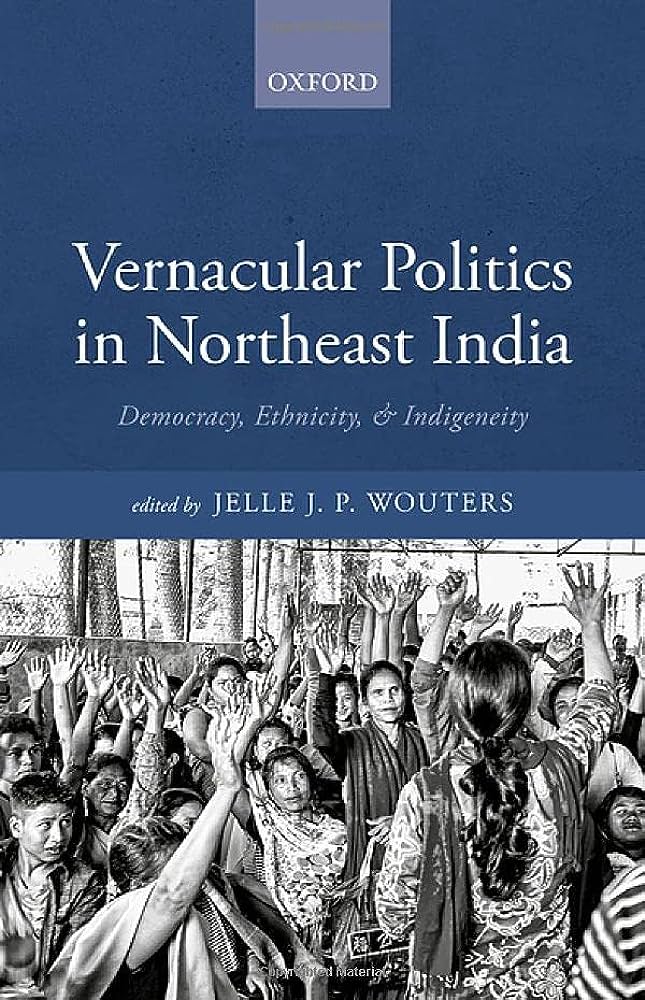
Vernacular Politics in Northeast India: Democracy, Ethnicity and Indigeneity edited by Jelle J.P. Wouters (published by Oxford University Press in 2022) begins with the author’s uncomfortable position reflecting upon or identifying with the ‘political’ in the North-East region of India. The volume makes a case for opening up the region to showcase the diverse factors that shape the ‘political’. In his introduction, the author points to the problems of locating the ‘Northeast’ in common parlance and the difficulty of translating its meaning in academia.
One of the thematic arguments that I also gathered is that there has been a shift from viewing the North East as a contentious zone of warring dualities. These include pre-colonial and post-colonial periods, separatism and unification and others. The volume places the region in the evolving political question of different claims to history and the contentious debate between those who are ‘inside’ and those ‘outside’ in a contest for regional supremacy. My reading of the introduction told me that the central question of the volume was to locate the ‘ethnic’ as the political manifestation of the vernacular or the ‘claims to indigeneity. While this is an interesting way to put it, there is a lack of clarity in expressing it.
The book itself is then divided into claims of vernacular historicity, ethnic political manoeuvring, ethno-territorialism, and the rhetoric of belonging – ‘us’ and the ‘other’. To begin with, Sean Dowdy’s essay on ‘Raijmel’ is an important anthropological contribution to understanding the Assamese psyche. The Raij and the Mel are both references to the making of the concept of polity in that region. While it is a contribution in which we do witness the people’s view of weighing various forms of authority at play simultaneously, the conclusion that it has produced a sphere of authority in the public domain and even social media spaces in Assam lacks conviction and seems forced.
Saba Sharma’s essay, By the Ballot, is an important contribution especially because of the internal dynamics it brings to light about the ethnic communities in the state of Assam, i.e. the Bodo and the Mias. The essay also says that a certain amount of dramatic performance is involved in how people seem to reclaim ethnic spaces by appealing to political representatives and amounts to the performative role of claiming citizenship. Kaustabh Deka’s article pieces out the story of political subjectivities anew, especially with regard to the passing of the Citizenship Amendment Bill of 2019 and the publication of the NRC in Assam. The twin events are even now at work in shaping Assamese to define the outsider. This is especially marked by the complex challenges of proving one’s lineage in documentary form, a feat impossible for most. Joy Pachau provides a robust narrative of Mizoram and the politics of ethnicity, the church, NGOs and a timeline in which migrant communities such as the Chakmas and Reangs all come into the mix of the political order. The above essays largely deal with the modern nature of political interventions outside the agency of the state that is at play in the region.
In the three essays discussing the ideas of cosmology and religious beliefs in connection to political authority, we can witness one common thread. All these issues are tied to complex politics of revivalism that are all located in the question of their belonging both to the nation and as ethnically distinct communities. Each chapter brings to light the possibilities of reviving a connection between man and the supernatural, through bonds of charisma as in the case of the God who becomes the python in the case of the Meiteis, the divine ordainment and gospel-like nature of the war for Nagamese liberation or the Konayak’s who are in a transition from traditional prophetic authority to something entirely new in the form of a priestess who has unorthodox ways of invoking a connection with the divine.
Wahlan and Karlsson, Nag and Gergan have developed an interesting take on the questions of indigeneity. The chapters which deal with Khasi matrilinity by highlighting it as a key aspect of vernacular identity in Meghalaya against those who contest it is a key point. It highlights the fragility of indigeneity as a concept meant to disenfranchise women and the ‘other’. The complex reproduction of the ‘other’ as proposed by Nag also cuts deep into the difficult placing of questions of who belongs to the North East states. Finally, Gergan very succinctly points out that the above questions require us to look beyond static concepts of belonging and think about agency. In his essay, it is largely to do with generational differences, and socio-political differences in a vision of development and holistic living for the people of Dzongu, Sikkim.
Many of the essays contribute to the conceptual changes in how one view indigeneity, especially when the question is more about the politics of producing the ‘other’ and reinvention of bio-ecological ties with land and nature. A few chapters appear out of place, some fall short in analysis. But some pertinent points are made. One does take away the important fact that the vernacular ways of understanding kinship, lineage, and autonomy of women’s choices to marriage, customary practices and religious beliefs as pillars of belonging to the region. The interesting aspect that I must point out, in this case, is how the vernacular is constantly modified and refitted to fit conservative fundamentalist agendas and reduce anything extant simultaneously which has the potential to go against such agendas. In a way, the recent inroads made by the BJP inside the North East can be understood in light of such agenda-based use of vernacular politicization.
***
Abir Lal Mazumder is a Guest Faculty at the Department of Anthropology, School of Social Sciences, University of Hyderabad.